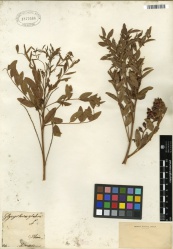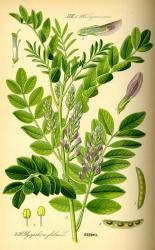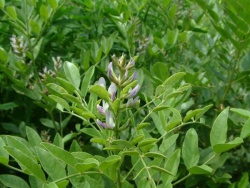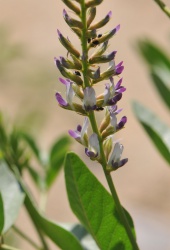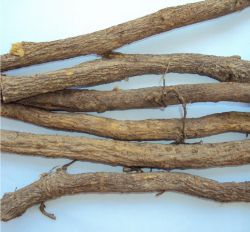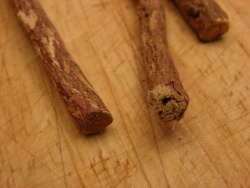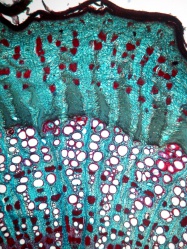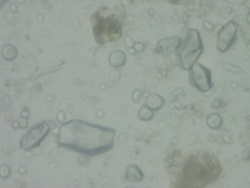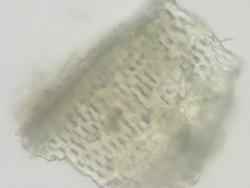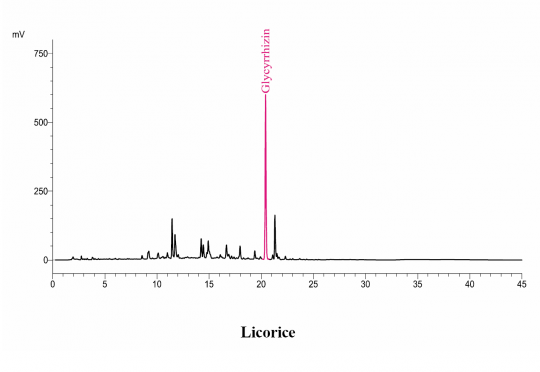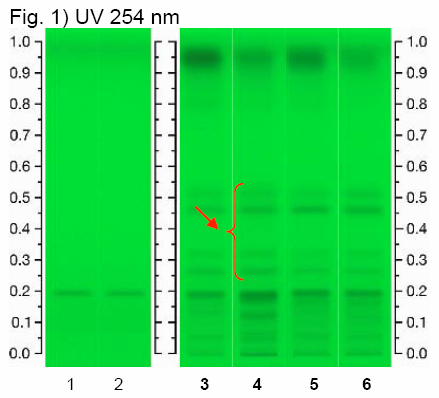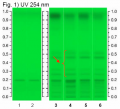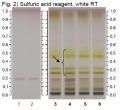Glycyrrhiza glabra (root)
(additional information from Hare, Caspari, Rusby National Standard Dispensatory (1905) (p733)) |
|||
| Line 83: | Line 83: | ||
<br>Powder: It shows plenty of starch grains, hexagonal crystals vessel elements are with reticulate wall pitting."}} | <br>Powder: It shows plenty of starch grains, hexagonal crystals vessel elements are with reticulate wall pitting."}} | ||
| + | |||
| + | {{Microscopy | source=Hare, Caspari, Rusby. National Standard Dispensatory (1905) | ||
| + | | description="The powder is identified by (1.) The character and location of starch-grains and crystals; (2) the very numerous bast-fibers of peculiar appearance and the almost identical wood-fibers; (3) The peculiar sieve-tissue. The starch-grains are irregularly spheroidal, mostly solitary, and range from 1.5 ore 2 to 20 microns in diameter. They are contained in medullary-ray and parenchyma-cells, and are often associated in the same cell with the monoclinic prismatic crystals of calcium oxalate, sometimes also with oil-gobules. The bast- and wood-fibers are yellow, thick-walled, and doubly pointed. Part of the sieve-tubes have their cavities nearly or quite obliterated by cell-wall thickening."}} | ||
{| border=1 | {| border=1 | ||
Revision as of 20:58, 3 March 2014
Contents |
Nomenclature
Glycyrrhiza glabra L. Fabaceae
Standardized common name (English): licorice
Ayurvedic name(s): yashtimadhu
Pinyin name(s): guang guo gan cao; gan cao (root & rhizome)
Botanical Voucher Specimen
|
|
Organoleptic Characteristics
|
Macroscopic Characteristics
|
Microscopic Characteristics
|
High Performance Liquid Chromatographic Identification
|
Licorice (root) (Glycyrrhiza glabra) Sample Preparations: Extract 1.0 g of coarsely powdered Glycyrrhiza root in 50 mL of water by boiling for about 5 minutes, and filter. Repeat for 4-5 times or until the extract is colorless. Combine the extracts, concentrate to about 100 mL, and cool to room temperature. Before injection, filter through a membrane filter of 0.45-um or finer pore size, discarding the first 5 mL of the filtrate. Column: C18, 25-cm x 4.6 mm, 5-um Mobile Phase: 0.14 g of anhydrous potassium dihydrogen phosphate in 900 mL of water, add 0.5 mL phosphoric acid, mix, complete to volume with water, and mix (Solution A); and acetonitrile (Solution B) Elution: Gradient program, see Table below Flow rate: 1.5 mL/min Detection: UV, 254 nm Injection volume: 20 uL Source: Natural Remedies Pvt Ltd [17] Table: Gradient program
|
High Performance Thin Layer Chromatographic Identification
|
Licorice (root) (Glycyrrhiza glabra) Lane Assignments Lanes, from left to right (Track, Volume, Sample):
Other Notes Reference Sample Preparations: Mix 0.5 g of powdered sample with 10 mL of ethanol and water (7:3, v/v), sonicate for 10 minutes, centrifuge or filter the solution, and use the supernatant / filtrate. Stationary Phase: HPTLC, Silica gel 60 F254 Mobile Phase: Ethyl acetate, acetic acid, formic acid, water (15:1:1:2) Development: Saturate chamber for 20 minutes; developing distance 70 mm from lower edge of the plate; relative humidity 33%, temperature 25°. Derivatization reagent: Methanol sulfuric acid reagent- 180 mL of ice-cooled methanol are mixed with 20 mL of sulfuric acid. Detection: a. Examine under UV light at 254 nm b. Dip (time 0, speed 5) in Derivatization reagent, heat at 100°C for 10 min, leave to cool, and examine under visible light. Procedure: Reference Standard Solutions, Stationary Phase, Mobile Phase, Development, Derivatization reagent, and Detection, as described above. Test Sample Preparation: Prepare test sample as described under Reference Sample Preparations and apply 2 uL. Identification: Compare Test Sample Preparation chromatogram with chromatograms of Reference Sample Preparations. The Test Sample Preparation chromatogram is similar to that of the Reference Sample Preparations chromatograms. Additional weak zones may be present. Under UV light, the Test Sample Preparation chromatogram exhibits a quenching zone in the lower-third section of the chromatogram corresponding to the zone due to ammonium glycyrrhizate in the Reference Standard Solution chromatogram. Above it there are four quenching zones corresponding to those marked with red arrows in the Reference Sample Preparations chromatograms. After derivatization and under visible light, the Test Sample Preparation chromatogram exhibits a brown zone in the lower-third section of the chromatogram corresponding to the zone due to ammonium glycyrrhizate in the Reference Standard Solution chromatogram. Above it there are four yellow zones corresponding to those marked with black arrows in the Reference Sample Preparations chromatograms. Note: Images presented in this entry are examples and are not intended to be used as a bases for setting specifications for quality control purposes. Source: HPTLC Association [18] |
Supplementary Information
Sources
- ↑ Tropicos.org. Missouri Botanical Garden. 27 Feb 2014 <http://www.tropicos.org/Image/100253567>
- ↑ Natural Remedies Pvt Ltd http://www.naturalremedy.com/
- ↑ American Herbal Products Association. March 2013. Organoleptic Analysis of Herbal Ingredients. AHPA: Silver Spring, MD http://www.ahpa.org/
- ↑ WHO monographs on selected medicinal plants, Vol.1, World Health Organization, Geneva, 1999
- ↑ Natural Remedies Pvt Ltd http://www.naturalremedy.com/
- ↑ Flora von Deutschland, Österreich und der Schweiz- Otto Wilhelm Thomé (1885)
- ↑ Encyclopedia of Life http://eol.org/data_objects/2447928
- ↑ Encyclopedia of Life http://eol.org/data_objects/24932881
- ↑ Natural Remedies Pvt Ltd http://www.naturalremedy.com/
- ↑ Encyclopedia of Life http://eol.org/data_objects/19163752
- ↑ WHO monographs on selected medicinal plants, Vol.1, World Health Organization, Geneva, 1999
- ↑ Natural Remedies Pvt Ltd http://www.naturalremedy.com/
- ↑ Hare, Caspari, Rusby. National Standard Dispensatory (1905)
- ↑ Natural Remedies Pvt Ltd http://www.naturalremedy.com/
- ↑ Natural Remedies Pvt Ltd http://www.naturalremedy.com/
- ↑ Natural Remedies Pvt Ltd http://www.naturalremedy.com/
- ↑ Natural Remedies Pvt Ltd http://www.naturalremedy.com/
- ↑ HPTLC Association http://www.hptlc-association.org/
- Botanical
- Fabaceae
- Macroscopy
- Natural Remedies Pvt Ltd
- American Herbal Products Association. March 2013. Organoleptic Analysis of Herbal Ingredients. AHPA: Silver Spring, MD
- WHO monographs on selected medicinal plants, Vol.1, World Health Organization, Geneva, 1999
- Microscopy
- Hare, Caspari, Rusby. National Standard Dispensatory (1905)
- HPTLC
- HPTLC Association
